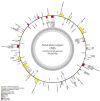The Mitochondrial Genome Assembly of Fennel (Foeniculum vulgare) Reveals Two Different atp6 Gene Sequences in Cytoplasmic Male Sterile Accessions
- PMID: 32630002
- PMCID: PMC7370444
- DOI: 10.3390/ijms21134664
The Mitochondrial Genome Assembly of Fennel (Foeniculum vulgare) Reveals Two Different atp6 Gene Sequences in Cytoplasmic Male Sterile Accessions
Abstract
Cytoplasmic male sterility (CMS) has always aroused interest among researchers and breeders, being a valuable resource widely exploited not only to breed F1 hybrid varieties but also to investigate genes that control stamen and pollen development. With the aim of identifying candidate genes for CMS in fennel, we adopted an effective strategy relying on the comparison between mitochondrial genomes (mtDNA) of both fertile and sterile genotypes. mtDNA raw reads derived from a CMS genotype were assembled in a single molecule (296,483 bp), while a draft mtDNA assembly (166,124 nucleotides, 94 contigs) was performed using male fertile sample (MF) sequences. From their annotation and alignment, two atp6-like sequences were identified. atp6-, the putative mutant copy with a 300 bp truncation at the 5'-end, was found only in the mtDNA of CMS samples, while the wild type copy (atp6+) was detected only in the MF mtDNA. Further analyses (i.e., reads mapping and Sanger sequencing), revealed an atp6+ copy also in CMS samples, probably in the nuclear DNA. However, qPCRs performed on different tissues proved that, despite its availability, atp6+ is expressed only in MF samples, while apt6- mRNA was always detected in CMS individuals. In the light of these findings, the energy deficiency model could explain the pollen deficiency observed in male sterile flower. atp6- could represent a gene whose mRNA is translated into a not-fully functional protein leading to suboptimal ATP production that guarantees essential cellular processes but not a high energy demand process such as pollen development. Our study provides novel insights into the fennel mtDNA genome and its atp6 genes, and paves the way for further studies aimed at understanding their functional roles in the determination of male sterility.
Keywords: ATP synthase; F1 hybrid breeding; energy deficiency model; male sterility; marker-assisted selection; mtDNA; organelle assembly; pollen.
Conflict of interest statement
The authors declare no conflicts of interest
Figures





Similar articles
-
Genetics, genomics and breeding of fennel.BMC Plant Biol. 2025 May 7;25(1):595. doi: 10.1186/s12870-025-06608-5. BMC Plant Biol. 2025. PMID: 40335931 Free PMC article. Review.
-
Extensive structural variations between mitochondrial genomes of CMS and normal peppers (Capsicum annuum L.) revealed by complete nucleotide sequencing.BMC Genomics. 2014 Jul 4;15(1):561. doi: 10.1186/1471-2164-15-561. BMC Genomics. 2014. PMID: 24996600 Free PMC article.
-
Genome-wide analysis of mRNA and lncRNA expression and mitochondrial genome sequencing provide insights into the mechanisms underlying a novel cytoplasmic male sterility system, BVRC-CMS96, in Brassicarapa.Theor Appl Genet. 2020 Jul;133(7):2157-2170. doi: 10.1007/s00122-020-03587-z. Epub 2020 Apr 16. Theor Appl Genet. 2020. PMID: 32399654
-
Identification of mitochondrial genome rearrangements unique to novel cytoplasmic male sterility in radish (Raphanus sativus L.).Theor Appl Genet. 2009 Feb;118(4):719-28. doi: 10.1007/s00122-008-0932-y. Epub 2008 Nov 26. Theor Appl Genet. 2009. PMID: 19034407
-
Comparative analysis of mitochondrial genomes between a wheat K-type cytoplasmic male sterility (CMS) line and its maintainer line.BMC Genomics. 2011 Mar 29;12:163. doi: 10.1186/1471-2164-12-163. BMC Genomics. 2011. PMID: 21443807 Free PMC article.
Cited by
-
Genetics, genomics and breeding of fennel.BMC Plant Biol. 2025 May 7;25(1):595. doi: 10.1186/s12870-025-06608-5. BMC Plant Biol. 2025. PMID: 40335931 Free PMC article. Review.
-
Intrageneric structural variation in organelle genomes from the genus Dystaenia (Apiaceae): genome rearrangement and mitochondrion-to-plastid DNA transfer.Front Plant Sci. 2023 Dec 5;14:1283292. doi: 10.3389/fpls.2023.1283292. eCollection 2023. Front Plant Sci. 2023. PMID: 38116150 Free PMC article.
-
Comparison of Mitochondrial Genomes between a Cytoplasmic Male-Sterile Line and Its Restorer Line for Identifying Candidate CMS Genes in Gossypium hirsutum.Int J Mol Sci. 2022 Aug 16;23(16):9198. doi: 10.3390/ijms23169198. Int J Mol Sci. 2022. PMID: 36012463 Free PMC article.
-
Characterization and phylogenetic analysis of the complete mitochondrial genome sequence of Diospyros oleifera, the first representative from the family Ebenaceae.Heliyon. 2022 Jul 6;8(7):e09870. doi: 10.1016/j.heliyon.2022.e09870. eCollection 2022 Jul. Heliyon. 2022. PMID: 35847622 Free PMC article.
-
Impact of Genomic and Transcriptomic Resources on Apiaceae Crop Breeding Strategies.Int J Mol Sci. 2021 Sep 8;22(18):9713. doi: 10.3390/ijms22189713. Int J Mol Sci. 2021. PMID: 34575872 Free PMC article. Review.
References
-
- Palumbo F., Galla G., Vitulo N., Barcaccia G. First draft genome sequencing of fennel (Foeniculum vulgare Mill.): Identification of simple sequence repeats and their application in marker-assisted breeding. Mol. Breed. 2018;38:122. doi: 10.1007/s11032-018-0884-0. - DOI
-
- Prasannan A. Hybrid Seeds Market by Crop, Duration, Seed Treatment, Farm Type and Acreage: Global Opportunity Analysis and Industry Forecast 2017-2023. Allied Market Research; Portland, OR, USA: 2017.
MeSH terms
Substances
LinkOut - more resources
Full Text Sources

